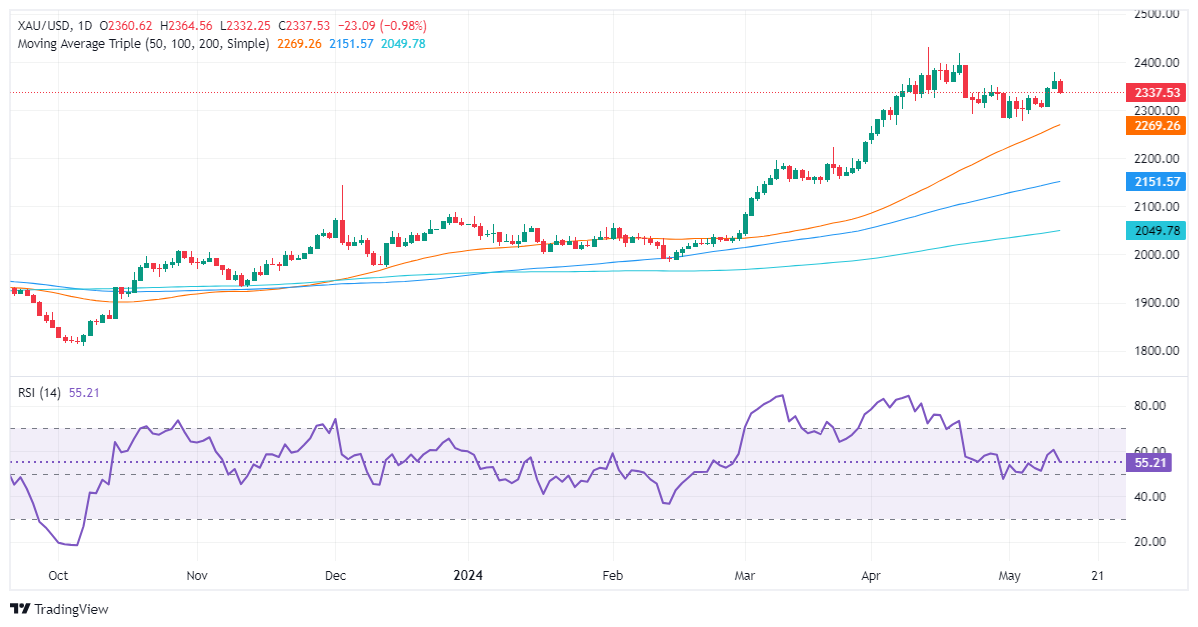- Gold falls 1%, retreating from $2,350, despite the decline in US Treasury yields, which usually provide support.
- US economic developments, including inflation data and Fed Chair Jerome Powell's speech, are poised to influence markets.
- Fed Vice Chairman Jefferson came down hard and stressed the importance of pushing inflation toward the 2% target.
Gold prices retreated sharply on Monday from near $2,350, even as US Treasury yields declined, undermining appetite for the dollar. Traders are preparing for a busy economic schedule in the United States, led by the release of inflation figures, retail sales and the May 14 speech by Federal Reserve Chairman Jerome Powell.
Earlier Monday, Fed Vice Chairman Philip Jefferson addressed the media in a question-and-answer session at Fed headquarters in Cleveland. He said: “We continue to look for further evidence that inflation will return to our 2% target.”
XAU/USD is trading at $2,336, down 1% on the day, amid bullish momentum. Wall Street continues to post gains. The latest labor market data, such as April Nonfarm Payrolls and last week's Initial Jobless Claims, could put pressure on the Fed. In their latest monetary policy statement, officials acknowledged that the risks to reaching the The Fed's dual mandate of promoting maximum employment and price stability have become more balanced over the past year.
Meanwhile, the US Bureau of Labor Statistics (BLS) is expected to release producer and consumer inflation data for April on May 14-15. If price pressure reaccelerates, the Fed can keep rates “higher for longer.”
Daily Market Moves Summary: Gold falls as US data could influence Fed rate path
- Gold prices fell amid declining US Treasury yields and the strength of the US Dollar. The 10-year US Treasury bond yield is yielding 4.479% and is down two basis points (bps) from its opening level. The US Dollar Index (DXY), which tracks the greenback against six other currencies, lost 0.10% to 105.20.
- The Production Price Index (PPI) for April is expected to be 0.3% monthly, one tenth above the previous month's figure. The core PPI is forecast at 0.2% monthly, unchanged from March.
- The Consumer Price Index (CPI) for April is expected to remain unchanged from the March reading, at 0.4% monthly. The core CPI is expected to resume its downward trend from 0.4% in March to 0.3% monthly.
- Investors are awaiting Fed Chairman Jerome Powell's speech on May 14.
- Other data will be released during the week, led by retail sales on May 15, initial jobless claims and industrial production on May 16.
- The New York Federal Reserve released its monthly Survey of Consumer Expectations on Monday, which showed inflation expectations for the year rose to 3.3%, up from 3% in March. The data came after the University of Michigan consumer sentiment survey showed one-year inflation expectations rose from 3.2% to 3.5%.
- Expectations of interest rate cuts at the end of the year remain at 34 basis points (bp), according to data provided by the Chicago Board of Trade (CBOT).
Technical Analysis: Gold Price Falls Below $2,350 and Bears Target $2,300
The bullish trend in the price of Gold remains intact, although from a technical perspective the formation of an almost shooting star candlestick pattern followed by a bearish Belt Hold line opened the door to a downward stretch. Although momentum favors buyers, the short term points to the downside, meaning they are losing traction.
Therefore, the first support for XAU/USD would be the May 9 low at $2,306, followed by $2,300. Once broken, the next stop would be the 50-day SMA at $2,249.
On the other hand, if buyers recover $2,359, we will have to look for the April 26 high at $2,352. A break of this last level would expose the $2,400 figure, followed immediately by the April 19 high at $2,417 and the all-time high at $2,431.

Frequently asked questions about Gold
Why invest in Gold?
Gold has played a fundamental role in human history, as it has been widely used as a store of value and medium of exchange. Today, apart from its brilliance and use for jewelry, the precious metal is considered a safe-haven asset, meaning it is considered a good investment in turbulent times. Gold is also considered a hedge against inflation and currency depreciation, since it does not depend on any specific issuer or government.
Who buys more Gold?
Central banks are the largest holders of Gold. In their aim to support their currencies in turbulent times, central banks tend to diversify their reserves and purchase Gold to improve the perception of strength of the economy and currency. High Gold reserves can be a source of confidence for the solvency of a country. Central banks added 1,136 tons of gold worth about $70 billion to their reserves in 2022, according to data from the World Gold Council. This is the largest annual purchase since records exist. Central banks in emerging economies such as China, India and Türkiye are rapidly increasing their gold reserves.
What correlation does Gold have with other assets?
Gold has an inverse correlation with the US Dollar and US Treasuries, which are the main reserve and safe haven assets. When the Dollar depreciates, the price of Gold tends to rise, allowing investors and central banks to diversify their assets in turbulent times. Gold is also inversely correlated with risk assets. A rally in the stock market tends to weaken the price of Gold, while sell-offs in riskier markets tend to favor the precious metal.
What does the price of Gold depend on?
The price of Gold can move due to a wide range of factors. Geopolitical instability or fear of a deep recession can cause the price of Gold to rise rapidly due to its status as a safe haven asset. As a non-yielding asset, the price of Gold tends to rise when interest rates fall, while rising money prices tend to weigh down the yellow metal. Still, most of the moves depend on how the US Dollar (USD) performs, as the asset is traded in dollars (XAU/USD). A strong Dollar tends to keep the price of Gold in check, while a weaker Dollar is likely to push up Gold prices.
Source: Fx Street
I am Joshua Winder, a senior-level journalist and editor at World Stock Market. I specialize in covering news related to the stock market and economic trends. With more than 8 years of experience in this field, I have become an expert in financial reporting.







